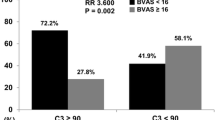Abstract
Objectives
A systemic inflammation response index (SIRI) has been recently introduced as a tool for the assessment of the prognosis of several critical medical conditions. In this study, we investigated whether SIRI at diagnosis could estimate the cross-sectional disease activity and predict poor prognosis during follow-up in patients with antineutrophil cytoplasmic antibody (ANCA)-associated vasculitis (AAV).
Methods
We reviewed the medical records of 224 immunosuppressive drug-naïve AAV patients and obtained clinical and laboratory data both at diagnosis and during follow-up. SIRI was calculated using the following equation: SIRI = peripheral blood neutrophil count × monocyte count/lymphocyte count.
Results
The median age of AAV patients at diagnosis was 59.0 years and 33% were male. In the univariable linear regression analysis, SIRI value at diagnosis was not significantly correlated with the cross-sectional Birmingham vasculitis activity score (BVAS) (r = 0.125, P = 0.062). When the SIRI cut-off value at diagnosis was set at 2847.9 mm−3 using the receiver operator characteristic curve, the sensitivity was 56.0% and the specificity was 68.3% for all-cause mortality [area 0.618, 95% confidence interval (CI) 0.502, 0.734]. AAV patients with SIRI ≥ 2847.9 mm−3 had a significantly higher risk for all-cause mortality than those with SIRI < 2847.9 mm−3 [relative risk (RR) 2.747, 95% CI 1.181, 6.392]. During follow-up, AAV patients with SIRI ≥ 2847.9 mm−3 exhibited a significantly lower patients’ survival rate than those with SIRI < 2847.9 mm−3 (P = 0.003).
Conclusions
SIRI at diagnosis could predict all-cause mortality during follow-up but it could not estimate the cross-sectional BVAS in AAV patients.


Similar content being viewed by others
References
Pacheco-Barcia V, Mondéjar Solís R, France T et al (2020) A systemic inflammation response index (SIRI) correlates with survival and predicts oncological outcome for mFOLFIRINOX therapy in metastatic pancreatic cancer. Pancreatology 20(2):254–264
Zheng Y, Chen Y, Chen J et al (2019) Combination of systemic inflammation response index and platelet-to-lymphocyte ratio as a novel prognostic marker of upper tract urothelial carcinoma after radical nephroureterectomy. Front Oncol 9:914
Jennette JC, Falk RJ, Bacon PA et al (2013) 2012 revised international chapel hill consensus conference nomenclature of vasculitides. Arthritis Rheum 65(1):1–11
Watts R, Lane S, Hanslik T, Hauser T et al (2007) Development and validation of a consensus methodology for the classification of the ANCA-associated vasculitides and polyarteritis nodosa for epidemiological studies. Ann Rheum Dis 66(2):222–227
Jennette JC, Falk RJ (2014) Pathogenesis of antineutrophil cytoplasmic autoantibody-mediated disease. Nat Rev Rheumatol 10(8):463–473
Brunini F, Page TH, Gallieni M, Pusey CD (2016) The role of monocytes in ANCA-associated vasculitides. Autoimmun Rev 15(11):1046–1053
Mukhtyar C, Lee R, Brown D et al (2009) Modification and validation of the Birmingham vasculitis activity score (version 3). Ann Rheum Dis 68(12):1827–1832
Guillevin L, Pagnoux C, Seror R et al (2011) The five-factor score revisited: assessment of prognoses of systemic necrotizing vasculitides based on the french vasculitis study group (FVSG) cohort. Medicine (Baltimore) 90(1):19–27
McAdoo SP, Medjeral-Thomas N, Gopaluni S et al (2019) Long-term follow-up of a combined rituximab and cyclophosphamide regimen in renal anti-neutrophil cytoplasm antibody-associated vasculitis. Nephrol Dial Transplant 34(1):63–73
Ahn SS, Jung SM, Song JJ, Park YB, Lee SW (2019) Prognostic nutritional index is associated with disease severity and relapse in ANCA-associated vasculitis. Int J Rheum Dis 22(5):797–804
Park HJ, Jung SM, Song JJ, Park YB, Lee SW (2018) Platelet to lymphocyte ratio is associated with the current activity of ANCA-associated vasculitis at diagnosis: a retrospective monocentric study. Rheumatol Int 38(10):1865–1871
Ahn SS, Jung SM, Song JJ, Park YB, Lee SW (2018) Neutrophil to lymphocyte ratio at diagnosis can estimate vasculitis activity and poor prognosis in patients with ANCA-associated vasculitis: a retrospective study. BMC Nephrol 19(1):187
O’Brien EC, Abdulahad WH, Rutgers A et al (2015) Intermediate monocytes in ANCA vasculitis: increased surface expression of ANCA autoantigens and IL-1β secretion in response to anti-MPO antibodies. Sci Rep 5:11888
Casselman BL, Kilgore KS, Miller BF, Warren JS (1995) Antibodies to neutrophil cytoplasmic antigens induce monocyte chemoattractant protein-1 secretion from human monocytes. J Lab Clin Med 126(5):495–502
Muller Kobold AC, Kallenberg CG, Tervaert JW (1999) Monocyte activation in patients with Wegener’s granulomatosis. Ann Rheum Dis 58(4):237–245
Proctor MJ, McMillan DC, Horgan PG, Fletcher CD, Talwar D, Morrison DS (2015) Systemic inflammation predicts all-cause mortality: a glasgow inflammation outcome study. PLoS ONE 10(3):e0116206
Isaac V, Wu CY, Huang CT, Baune BT, Tseng CL, McLachlan CS (2016) Elevated neutrophil to lymphocyte ratio predicts mortality in medical inpatients with multiple chronic conditions. Medicine (Baltimore) 95(23):e3832
Choi SH, Kim JH, Lim S et al (2017) Monocyte count as a predictor of cardiovascular mortality in older Korean people. Age Ageing 46(3):433–438
Acknowledgements
This research was supported by a faculty research Grant of Yonsei University College of Medicine (6-2019-0184) and a Grant from the Korea Health Technology R&D Project through the Korea Health Industry Development Institute, funded by the Ministry of Health and Welfare, Republic of Korea (HI14C1324).
Author information
Authors and Affiliations
Corresponding author
Ethics declarations
Conflict of interest
The authors declare that they have no competing interests.
Ethical approval
This study was approved by the Institutional Review Board of Severance Hospital (4-2017-0673) and the patients’ written informed consent was obtained at the time of blood sampling.
Additional information
Publisher's Note
Springer Nature remains neutral with regard to jurisdictional claims in published maps and institutional affiliations.
Supplementary Information
Below is the link to the electronic supplementary material.
Rights and permissions
About this article
Cite this article
Lee, L.E., Pyo, J.Y., Ahn, S.S. et al. Systemic inflammation response index predicts all-cause mortality in patients with antineutrophil cytoplasmic antibody-associated vasculitis. Int Urol Nephrol 53, 1631–1638 (2021). https://doi.org/10.1007/s11255-020-02777-4
Received:
Accepted:
Published:
Issue Date:
DOI: https://doi.org/10.1007/s11255-020-02777-4




